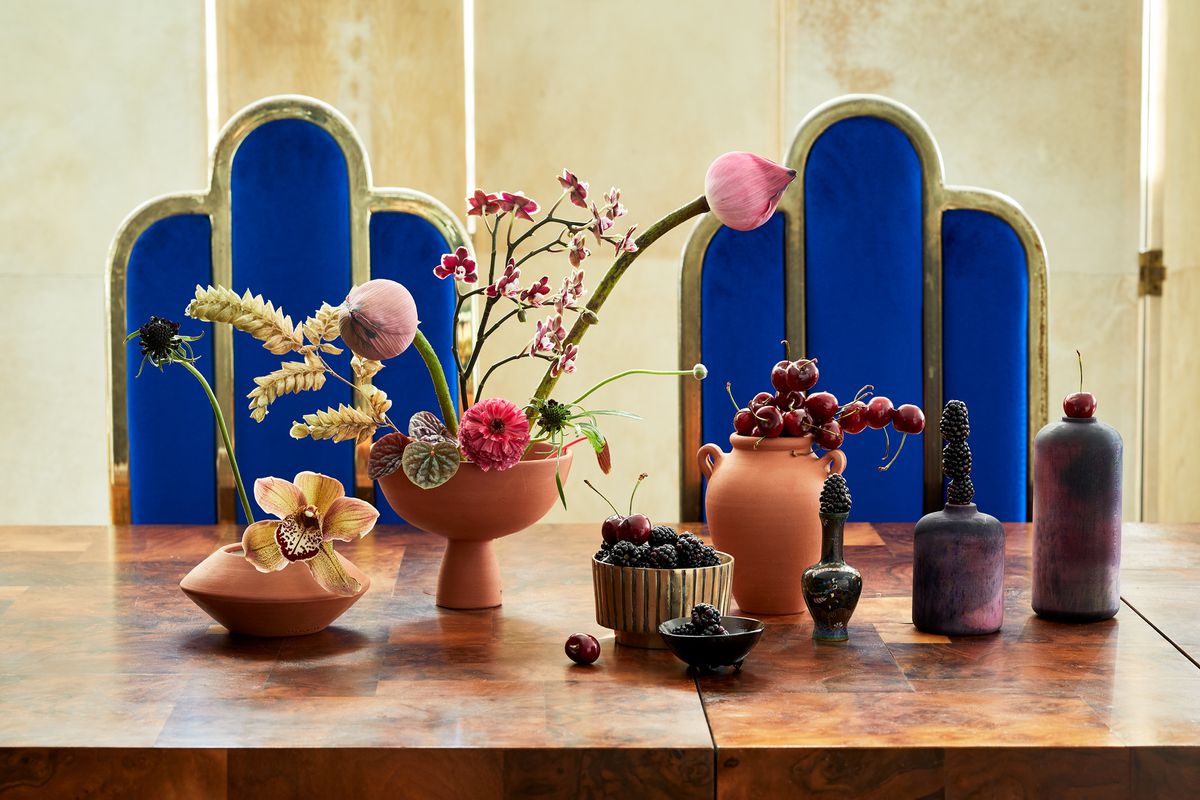The Only Floral Arranging Tools You’ll Need, According to a Pro - 5 minutes read

When Ingrid Carozzi, founder of Redhook, Brooklyn-based floral design company Tin Can Studios, is working with clients like Vogue, the Queen of Sweden, and designer Carolina Herrera, it’s usually for extravagant events with impressive large-scale installations. Think hundreds of blossoms cascading from the ceiling over a candlelit dining table, undulating vines that snake up structural columns in an event space, and huge budgets. But even she is no stranger to grocery store florals or a handful of foraged greenery.
In her latest book "Flowers By Design: Creating Arrangements For Your Space" out this November, Carozzi distills everything she's learned from eight years in the industry with super easy-to-follow directions, practical tips, and tons of inspiration to bring flowers into our homes in fresh ways. “I want to encourage people to find inspiration outside of the digital sphere—look at fashion, look at cooking, look at interior design, and find your inspiration there,” says Carozzi.
To help make her point that no matter your aesthetic or budget, the book is packed with her signature flower “recipes,” aptly named because she often thinks of floral design in culinary terms. “For the book, I wanted to take a Sam Sifton approach. You might start with one of my base recipes, but you can make it your own depending on the flowers you’re able to find locally,” explains Carozzi, whose faves include farm flowers like poppies, cosmos, and dahlias. “Local flowers are just more natural. They haven't been smushed in a box and shipped thousands of miles, and they just feel bouncy and fresh,” she says.
While the first half of the book serves as inspiration to find a floral style that speaks to you, the second transitions to more technical how-tos. The tips and techniques include advanced ideas like flexing tulips (the act of flipping petals outward to create more volume), as well as a rundown of flower-care basics and pro tricks, like how to get peonies to open (spray the buds with lukewarm water, then shake off any excess). All of which are presented through an eco-conscious lens, one of Carozzi’s core tenets.
Even though Carozzi’s projects range in scale and budget from minimalist Japanese-inspired displays that use just a few blooms to immersive installations that hang from the ceiling or creep up a wall, she reaches for the same essentials each time such as a pair of sharp clippers, chicken wire, and a mister. So, to aid in your own at-home floral adventures, we asked Carozzi to share her list of absolute essentials—the items she uses on repeat and should be in the arsenal of anyone working with flowers. Below, her curated lineup.
Photo by Bobbi Lin
There’s an entire section in Carozzi’s book dedicated to picking the right vase (generally speaking, follow the golden ratio: 3/4 flowers to 1/4 vase) and the importance of doing so. But there are three vessel style that she thinks every burgeoning floral designer should have on hand: a footed compote so elements in your arrangement can spill out, a low bowl for ikebana-inspired designs, and a vase with a bottom that’s wider than its opening so that stems can be angled and don’t have to stand straight up.
Chances are you might have a vase, but not a bowl. “The small-bowl vessel from this collection is perfect for anyone who wants to create a lush, organic arrangement because it allows you to have blooms spilling out over the sides. I turn to this vase regularly for my floral design work at Tin Can Studios," says Carozzi.
Photo by Crate Barrel
“I build my arrangement on these, so I can easily spin it to see all sides," says Carozzi. "A marble option is better than wood because the surface is bound to get wet while you’re working.”
Photo by Afloral
“Using a pin frog is a great way to ensure your stems stay in place and give you more control over their placement. They’re especially suited for minimal, ikebana-inspired arrangements.”
Photo by Rocky Luten
“Sharp flower clippers are essential to ensure that each bloom’s stem is cut properly and the flower can drink. These are great because they’re comfortable to hold, and I like the aesthetic.”
Photo by Lowe's
“This is a handy solution to ensure your clippers are always closeby.”
Photo by Amazon
“I could never live without chicken wire—it’s an essential tool for my work with flowers. It gives you control over the structure of an arrangement and allows you to move stems around as much as you want. And it’s an excellent sustainable solution because it’s infinitely reusable.”
Photo by Jamali Garden
“Use this waterproof tape to secure your chicken wire in the vase. A simple x-shape across the opening should do the trick. I prefer the ¼ inch version, so the tape doesn’t get in the way too much.”
Photo by Julia Gartland
“A watering can with a long, narrow spout is the easiest way to top up a vase once you’ve completed an arrangement.”
Photo by Amazon
“After I complete an arrangement, I always finish it with a light mist of water to hydrate the blooms. But you don’t want to see droplets, so a spray bottle that gives off a fine mist, like this one, is ideal.”
Photo by Ty Mecham
“I love mixing fruit [in with flowers for] my tablescape designs—it adds an additional layer of visual interest. These bowls are ideal for that. Try loading them up with blackberries or cherries at your next dinner party.”
What kinds of flowers do you love putting in arrangements? Let us know below!
This post contains products independently chosen (and loved) by our editors and writers. Food52 earns an affiliate commission on qualifying purchases of the products we link to.
Source: Food52.com
Powered by NewsAPI.org